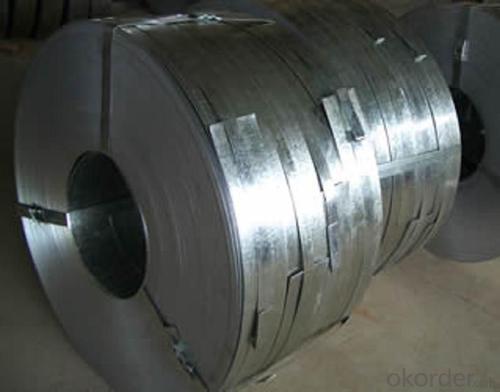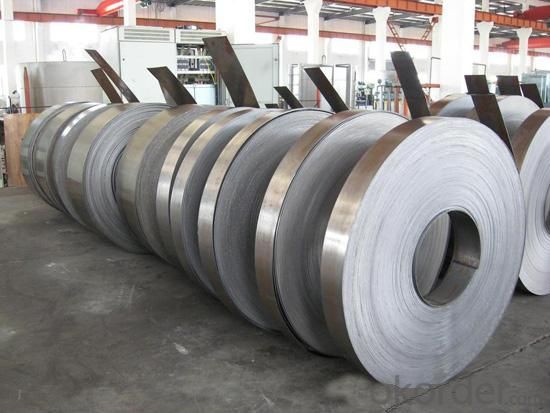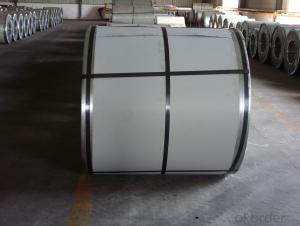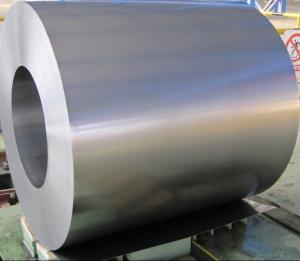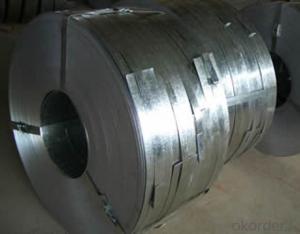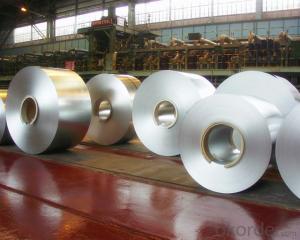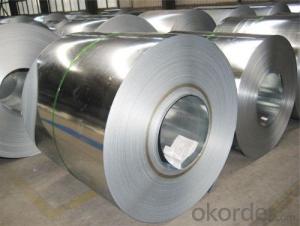Galvanized Steel Strip with Width from 630mm
- Loading Port:
- Tianjin
- Payment Terms:
- TT OR LC
- Min Order Qty:
- 25 m.t.
- Supply Capability:
- 20000 m.t./month
OKorder Service Pledge
OKorder Financial Service
You Might Also Like
1.Structure of Hot-Dip Galvanized Steel Strips Description:
Hot-dip galvanized steel coils are available with a pure zinc coating through the hot-dip galvanizing process. It offers the economy, strength and formability of steel combined with the corrosion resistance of zinc. The hot-dip process is the process by which steel gets coated in layers of zinc to protect against rust. It is especially useful for countless outdoor and industrial applications. Production of cold formed corrugated sheets and profiles for roofing, cladding, decking, tiles, sandwich walls, rainwater protective systems, air conditioning duct as well as electrical appliances and engineering.
2. Main Features of the Hot-Dip Galvanized Steel Strips:
• Excellent process capability
• Smooth and flat surface
• Workability, durability
• Excellent anticorrosive property
• High strength
• Good formability
• Good visual effect
3. Hot-Dip Galvanized Steel Strips Images
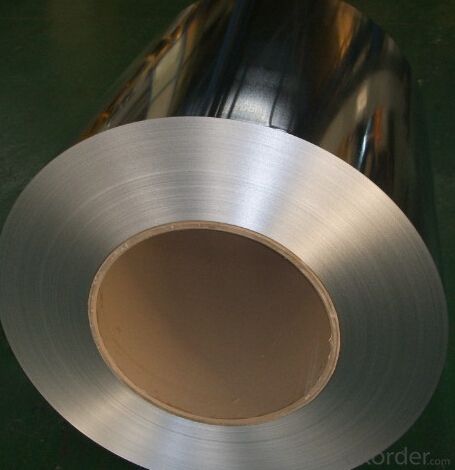
5.FAQ of Hot-Dip Galvanized Steel Strips
We have organized several common questions for our clients,may help you sincerely:
1. How about your company?
We’re state-owned company, controlled by central government. We also TOP 500. For galvanized steel sheet products, we have regular delivery to all over world every month.
2. How to guarantee the quality of the products?
We have established the international advanced quality management system,every link from raw material to final product we have strict quality test;We resolutely put an end to unqualified products flowing into the market. At the same time, we will provide necessary follow-up service assurance.
3. How long can we receive the product after purchase?
Production period is 30 days. And we’d prefer you can give us more time to book vessel.
4. Hot-Dip Galvanized Steel Strips Specification
1) Capacity: about 15,000 tons per month for sheet product.
2) Standard: JIS G3302 1998, ASTM A653M/A924M 2004, all according to the customer's request
3) Thickness: 0.13mm-0.5mm
4) Width: 400mm-1000mm
5) Length: We can adjust the length according to your request
6) Zinc Coating Weight: 60g/m2-275g/m2
7) Raw Materials: Galvanized steel sheet and Pre-painted galvanized steel sheet
8) Spangle: Regular spangle, minimized spangle and zero spangle
9) Hardness: Full hard, normal
- Q: What is the (balanced) chemical equation for steel?
- I hate to differ but I must. Steel is a mixture of iron and carbon but the carbon content ranges from a small fraction of a percent to no more than 2%. Stainless steel is an alloy of Iron and up to 15% or so of other metals but since there are several types and many varieties in each type it's hardly worth getting into. A good common hardenable high-carbon spring steel is AISI 1095. In this code the 95 refers to 0.95% carbon. When the carbon level goes up to 1.5% to 2% the steel is very brittle and black with the highest carbon steel being pretty much pig-iron.
- Q: What are the common methods of cutting-to-length steel coils?
- Depending on the industry's specific requirements and capabilities, there are various common methods used to cut-to-length steel coils. 1. Shearing: For thinner gauge materials, one can utilize shearing, which involves using a shear blade to cut the steel coil into specific lengths. This cost-effective method is ideal for high-volume production. 2. Slitting: For narrower strips or multiple widths from a single coil, slitting is a suitable process. It entails passing the steel coil through rotating circular blades that cut the coil into desired widths. Slitting is commonly used for thinner gauge materials. 3. Laser cutting: To achieve precise and clean cuts, laser cutting employs a high-powered laser beam that melts and vaporizes the steel coil. This method is versatile, suitable for a wide range of materials, complex shapes, and contours. Laser cutting is often chosen for high-precision applications and smaller production runs. 4. Sawing: Thicker gauge materials are commonly cut using sawing. This method, which can be done manually or with automated sawing machines, involves using a saw blade to cut through the steel coil. Sawing is ideal for cutting large sections or heavy-duty applications. 5. Rotary cutting: Rotary cutting is frequently employed for thicker gauge materials in high-speed production. This method utilizes a rotary shear to cut the steel coil into desired lengths, providing a clean and accurate cut. Many industries prefer rotary cutting. It is important to consider that each method has its own advantages and limitations. The appropriate cutting method selection depends on factors such as material thickness, coil width, required precision, production volume, and budget constraints.
- Q: I am in the market for a good hunting knife under $100. I am primarily looking for a knife that will keep it's edge. What type of steel should I be looking for?
- Take a close look at the Cold Steel Master Hunter. I can't wait for my hunting knife to die so I can go get one.
- Q: Suppose you made a sword out of diamond (just follow me here, it's only theoretical). Would it be lighter than a sword of the same size made out of steel?
- Diamond has half the density of steel but would make a terrible sword because it is not very tough. Toughness is a material's ability to resist breakage from forceful impact: Diamond has a toughness of 2.0 MPa·m1/2 and has a critical stress intensity factor of 3.4 MN·m?3/2. That makes it tough for a gem but are poor compared with steels. Plus diamond has a cleavage plane.
- Q: What are the challenges in coil slitting for thin gauge materials?
- Successfully operating coil slitting for thin gauge materials involves addressing a specific set of challenges. One major challenge is ensuring the proper handling and stability of the thin gauge material. The material's susceptibility to deformation, wrinkling, or tearing increases as it becomes thinner. To tackle this, careful attention must be given to the handling equipment and techniques used during the slitting process. This is necessary to maintain the appropriate tension and support throughout the operation. Another challenge is maintaining consistent and precise slitting widths. Thin gauge materials are often used in applications where accuracy is crucial, such as electronic components or automotive parts. Any variation in the slitting width can cause functional defects or assembly problems. Achieving precise slitting widths in thin gauge materials requires the use of high-quality slitting knives, well-maintained slitting machinery, and accurate tension control systems. In addition, thin gauge materials are more prone to surface defects, such as scratches or burrs, during the slitting process. These defects can impact the material's appearance, performance, or even its safety. To minimize the occurrence of surface defects, it is important to carefully select slitting knives and regularly maintain the slitting machinery. Furthermore, thin gauge materials often possess a higher yield strength, making them more resistant to deformation. This poses a challenge when it comes to achieving clean and straight edges during the slitting process. Special considerations must be taken to ensure that the slitting knives are sharp and properly aligned, allowing for clean cuts without introducing any edge defects. Lastly, thin gauge materials are generally more sensitive to external factors such as temperature, humidity, or static electricity. These factors can affect the material's dimensional stability, resulting in variations in slitting width or other quality issues. Therefore, it is crucial to establish appropriate environmental conditions and implement effective anti-static measures to minimize the impact of these factors. To summarize, the challenges associated with coil slitting for thin gauge materials revolve around handling and stability, maintaining precise slitting widths, minimizing surface defects, achieving clean and straight edges, and mitigating the influence of external factors. Overcoming these challenges requires a combination of suitable equipment, techniques, and operational controls to ensure high-quality slitting outcomes.
- Q: What are the different types of welding methods used for steel coils?
- There are several different types of welding methods used for steel coils, including gas metal arc welding (GMAW), flux-cored arc welding (FCAW), shielded metal arc welding (SMAW), and submerged arc welding (SAW). Each method has its own advantages and is used based on the specific requirements of the project.
- Q: How are steel coils used in the production of scaffolding?
- Steel coils are used in the production of scaffolding as they are typically cut and shaped into various components such as tubes, frames, and brackets. These coils provide the necessary strength and durability required for scaffolding structures, ensuring the safety and stability of workers who use them.
- Q: What are the different types of steel coil finishes?
- There are several different types of steel coil finishes, including mill finish, galvanized finish, painted finish, and stainless steel finish.
- Q: Bronze came before steel, right? thanks
- Yes; a very long time. 1000 years (?) Or even a bit more.
- Q: What are the common methods of welding steel coils?
- The common methods of welding steel coils include shielded metal arc welding (SMAW), gas metal arc welding (GMAW), flux-cored arc welding (FCAW), and submerged arc welding (SAW).
Send your message to us
Galvanized Steel Strip with Width from 630mm
- Loading Port:
- Tianjin
- Payment Terms:
- TT OR LC
- Min Order Qty:
- 25 m.t.
- Supply Capability:
- 20000 m.t./month
OKorder Service Pledge
OKorder Financial Service
Similar products
Hot products
Hot Searches
Related keywords



